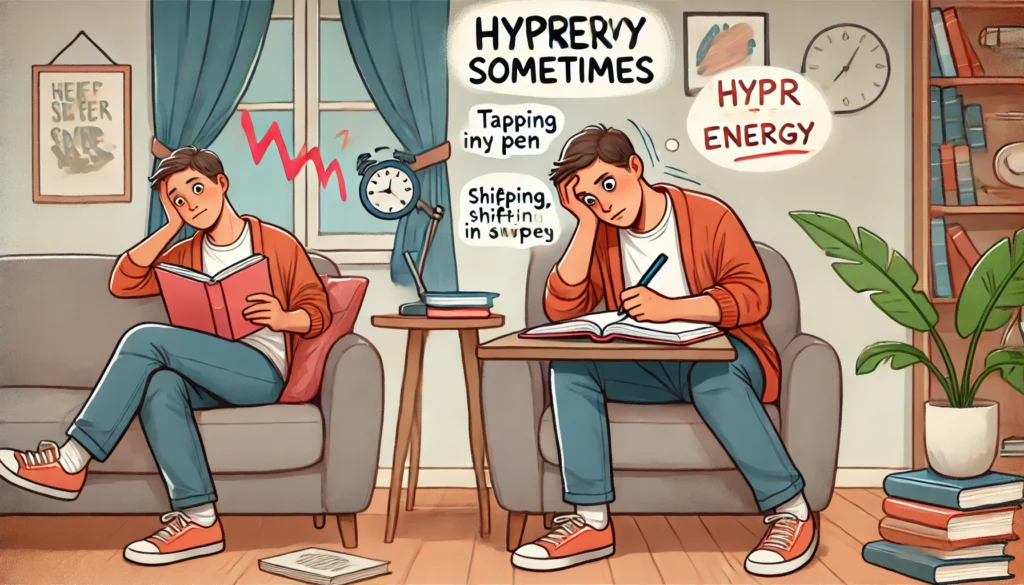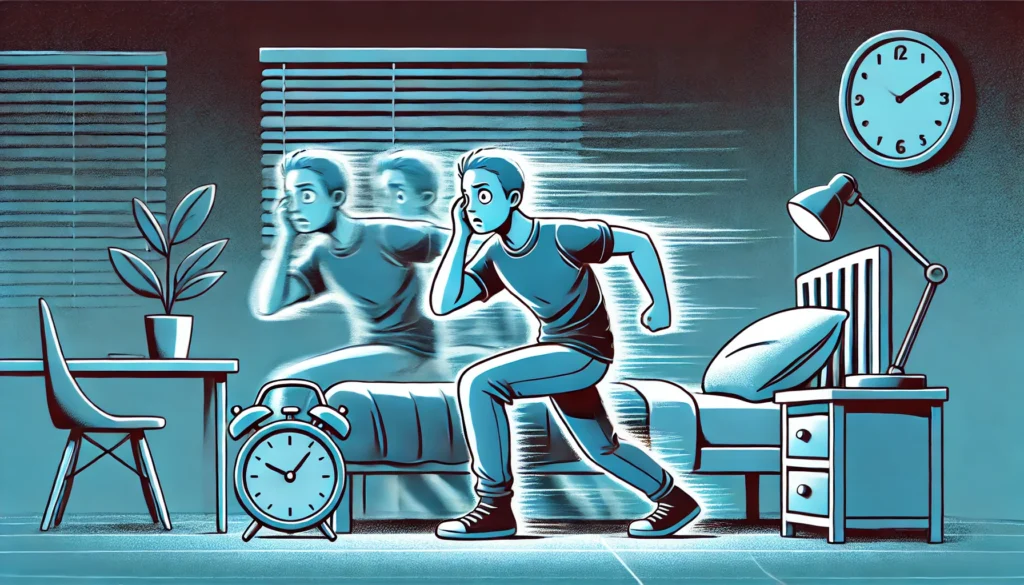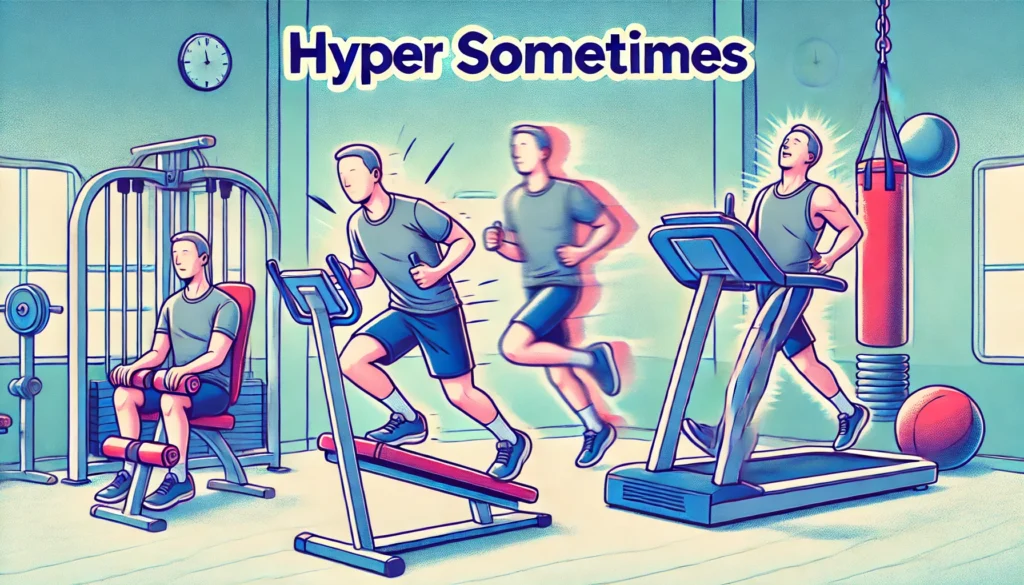Hyperactivity is often associated with disorders such as Attention Deficit Hyperactivity Disorder (ADHD), but it’s important to distinguish between clinical hyperactivity and occasional hyper feelings. While ADHD is a neurodevelopmental disorder characterized by persistent patterns of inattention and hyperactivity-impulsivity, feeling hyper sometimes is a more common experience that can occur in anyone.
You may also like: Enhancing Concentration: Strategies for ADHD
The Different Faces of Hyperactivity
Not all hyperactivity is created equal. It can manifest as physical restlessness, where one finds it hard to sit still, or as a mental overload, where thoughts race uncontrollably. Some experience it as an overwhelming urge to talk or engage in activities, while others might feel a surge in creativity or productivity. Understanding these variations can help tailor strategies to manage them effectively.
Temporary vs. Persistent Hyperactivity
Occasional hyperactivity is usually short-lived and tied to specific events or stimuli, such as consuming caffeine or experiencing excitement. In contrast, persistent hyperactivity, such as that seen in ADHD, is a consistent pattern that affects multiple areas of life, including work, relationships, and personal well-being. Recognizing the duration and impact of these hyper states is crucial for proper management.
Impact on Daily Life
Feeling hyper can affect daily activities in various ways. While it might enhance performance in high-energy situations, it can also disrupt focus and lead to exhaustion if not managed properly. It can influence social interactions, where one might seem overly enthusiastic or interruptive, and can challenge routine tasks, requiring more effort to maintain concentration.
The Role of Neurotransmitters
Neurotransmitters, the brain’s chemical messengers, play a significant role in regulating mood and energy levels. Dopamine, known for its role in pleasure and reward, is often linked to hyperactivity. High levels of dopamine can lead to increased energy and alertness, contributing to those hyper moments.
Dopamine and Its Effects
Dopamine is like the brain’s own version of a motivational speaker. It not only enhances energy levels but also boosts mood and promotes a sense of achievement. However, too much dopamine can lead to impulsive behaviors and difficulty in controlling thoughts, which might contribute to feeling hyper or even anxious.
The Stress Connection: Norepinephrine
Norepinephrine is another key player in the body’s response to stress and excitement. It prepares the brain and body for action, enhancing alertness and focus. While beneficial in moderation, excessive norepinephrine can lead to anxiety and overstimulation, which might exacerbate feelings of hyperactivity.
Balancing Neurotransmitters
Maintaining a balance in neurotransmitter levels is crucial for emotional and mental well-being. Factors like diet, exercise, and sleep play significant roles in regulating these chemicals. For instance, regular physical activity can help modulate dopamine levels, while adequate sleep is essential for neurotransmitter replenishment and balance.

Environmental and Lifestyle Factors
Several environmental and lifestyle factors can trigger feelings of hyperactivity. Consuming caffeine or sugar, for instance, can cause temporary spikes in energy levels. These substances stimulate the central nervous system, leading to increased alertness and sometimes jitteriness.
The Caffeine and Sugar Connection
Caffeine is a well-known stimulant that can enhance alertness and concentration. However, excessive consumption can lead to jitteriness and anxiety, creating a cycle of hyperactivity followed by a crash. Similarly, sugar provides a quick energy boost but can result in fluctuating energy levels and mood swings.
Sleep Deprivation and Hyperactivity
Paradoxically, lack of sleep can lead to hyperactivity. The body’s attempt to compensate for fatigue might involve releasing stress hormones like cortisol, which can temporarily heighten alertness. This state of hyperactivity, however, is unsustainable and can lead to increased stress and cognitive decline over time.
The Role of Physical Environment
The physical environment can significantly impact energy levels and hyperactivity. Bright lights, loud noises, or cluttered spaces can overstimulate the senses, leading to heightened alertness and stress. Creating a calming environment with minimal distractions can help manage feelings of hyperactivity.
Psychological Influences
Emotionally charged situations, such as stress or excitement, can also lead to feeling hyper. When faced with a challenging task or a thrilling experience, the body’s fight-or-flight response is activated, releasing adrenaline and increasing heart rate. This physiological response can manifest as hyperactivity.
The Fight-or-Flight Response
The fight-or-flight response is a survival mechanism that prepares the body to face threats. It involves the release of adrenaline, which increases heart rate and energy levels. While useful in emergencies, frequent activation due to stress or anxiety can lead to chronic hyperactivity and exhaustion.
Emotional Triggers and Hyperactivity
Emotions like excitement, anxiety, or fear can trigger hyperactivity. Positive stress, such as anticipation of a joyful event, can energize and motivate, while negative stress might lead to agitation and restlessness. Understanding these emotional triggers can help in developing strategies to manage hyper states.
The Power of Positive Thinking
Positive thinking can influence energy levels and mood. Focusing on positive outcomes and maintaining an optimistic outlook can reduce stress and promote a calmer state of mind. Techniques like gratitude journaling and affirmations can enhance mental resilience and help manage hyperactivity.
Hyperactivity vs ADHD: Key Differences
While feeling hyper sometimes is normal, understanding the distinction between occasional hyperactivity and ADHD is crucial. ADHD is a chronic condition that begins in childhood and can persist into adulthood. It involves more than just hyperactivity; it includes symptoms of inattention and impulsivity that interfere with daily functioning.
Understanding ADHD as a Spectrum
ADHD is not a one-size-fits-all condition. It exists on a spectrum, with varying degrees of severity and symptom presentation. Some individuals may experience predominantly inattentive symptoms, while others might exhibit more hyperactive-impulsive behaviors. Recognizing this spectrum is essential for accurate diagnosis and treatment.
Criteria for Diagnosing ADHD
To diagnose ADHD, mental health professionals refer to criteria outlined in the Diagnostic and Statistical Manual of Mental Disorders (DSM-5). These criteria include:
- Persistent patterns of inattention and/or hyperactivity-impulsivity
- Symptoms present before the age of 12
- Symptoms occur in two or more settings (e.g., school, home)
- Symptoms interfere with social, academic, or occupational functioning
Understanding these criteria helps differentiate ADHD from occasional hyperactivity, which lacks the chronicity and functional impairment associated with the disorder.
The Impact of ADHD on Life
ADHD can affect various aspects of life, from academic performance to personal relationships. Individuals may struggle with time management, organization, and impulse control. Recognizing these challenges is the first step in seeking appropriate interventions and support to improve quality of life.

Managing Hyperactivity in ADHD
For individuals with ADHD, managing hyperactivity involves a combination of behavioral interventions, medication, and lifestyle modifications. Cognitive-behavioral therapy (CBT) can help individuals develop strategies to manage impulsivity and improve focus. Medications like stimulants (e.g., methylphenidate) are commonly prescribed to help regulate neurotransmitter activity.
Behavioral Interventions
Behavioral interventions focus on modifying the environment and developing coping strategies. Techniques such as positive reinforcement, structured routines, and time management skills can help individuals with ADHD manage their symptoms more effectively.
The Role of Medication
Medication can be a crucial component of ADHD management. Stimulants like methylphenidate and amphetamines are often prescribed to enhance concentration and reduce hyperactivity. Non-stimulant medications, such as atomoxetine, may also be used, especially for individuals who do not respond well to stimulants.
Lifestyle Modifications for ADHD
Lifestyle changes can significantly impact ADHD symptoms. Regular physical activity, a balanced diet, and adequate sleep are essential for maintaining neurotransmitter balance and overall well-being. Additionally, mindfulness practices can enhance focus and reduce stress, supporting better management of ADHD.
Coping with Feeling Hyper Sometimes
For those who experience occasional hyperactivity, there are strategies to manage and channel this energy effectively.
Mindfulness and Relaxation Techniques
Practicing mindfulness and relaxation techniques can help calm the mind and body. Deep breathing exercises, meditation, and yoga can reduce stress and promote relaxation, helping to balance energy levels.
Embracing Mindfulness Practices
Mindfulness involves focusing on the present moment without judgment. Techniques such as guided meditation, progressive muscle relaxation, and mindful breathing can help reduce stress and calm hyperactive states. These practices enhance self-awareness and promote emotional regulation.
Creating a Relaxing Environment
A calming environment can significantly impact mental and physical well-being. Soft lighting, soothing music, and comfortable spaces can help induce relaxation and reduce hyperactivity. Creating a designated relaxation area at home or work can provide a sanctuary for unwinding.
Structured Routines
Establishing structured routines can provide a sense of stability and predictability. Creating a daily schedule that includes time for work, leisure, and rest can help manage periods of hyperactivity and prevent burnout.
The Importance of Routine
Routines create a framework for daily activities, reducing uncertainty and stress. By planning and organizing tasks, individuals can better manage their time and energy, minimizing the impact of hyperactivity on productivity and well-being.
Balancing Work and Leisure
Striking a balance between work and leisure is crucial for maintaining energy levels. Allocating specific times for focused work, relaxation, and hobbies can prevent burnout and enhance overall quality of life. This balance ensures that hyper moments are used productively without overwhelming the individual.
Physical Activity
Regular physical activity is a powerful way to manage energy levels. Exercise helps regulate neurotransmitter activity and can reduce feelings of restlessness. Incorporating activities like walking, running, or swimming into your routine can provide an outlet for excess energy.
The Benefits of Regular Exercise
Exercise releases endorphins, which are natural mood elevators. Engaging in physical activities not only helps manage hyperactivity but also improves overall health and well-being. Regular exercise can enhance concentration, reduce stress, and promote better sleep, contributing to a balanced lifestyle.
Choosing the Right Activity
Finding the right exercise routine is essential for maintaining motivation and consistency. Activities such as yoga or tai chi offer both physical and mental benefits, while more vigorous options like running or cycling can provide a greater release of energy. Personal preferences should guide the choice of activity.
Integrating Movement into Daily Life
Incorporating movement into daily routines can help manage energy levels throughout the day. Simple practices like taking short walks, stretching breaks, or using a standing desk can promote physical activity and reduce hyperactive feelings. These small changes can lead to significant improvements in overall well-being.

Future Implications and Trends
As research into the brain and behavior continues to evolve, our understanding of hyperactivity and its underlying mechanisms will deepen. Advances in neuroimaging and genetics may offer new insights into the biological basis of hyperactivity and lead to more targeted interventions.
Advances in Neuroimaging
Neuroimaging technologies, such as fMRI and PET scans, are providing new insights into brain activity associated with hyperactivity. These advances allow researchers to observe the brain’s response to various stimuli, enhancing our understanding of hyperactive states and informing more precise interventions.
Genetic Research and Hyperactivity
Genetic research is uncovering the hereditary aspects of hyperactivity and related disorders. Identifying specific genes associated with these conditions can lead to personalized treatment approaches, taking into account an individual’s unique genetic makeup and improving outcomes.
The Rise of Biohacking and Nootropics
The growing interest in biohacking and nootropics presents opportunities for individuals to explore ways to optimize their mental and physical performance. As more people seek to enhance their cognitive abilities, understanding the psychology behind feeling hyper will become increasingly relevant.
Personalized Interventions and Future Possibilities
As our understanding of hyperactivity deepens, personalized interventions become more feasible. Tailoring treatments to individual needs, preferences, and genetic profiles can enhance effectiveness and improve quality of life. Future trends may include the integration of technology and innovative therapies to address hyperactivity more comprehensively.
Conclusion
Feeling hyper sometimes is a complex interplay of biological, psychological, and environmental factors. By understanding the underlying mechanisms, individuals can better manage their energy levels and harness their heightened states for productive and creative endeavors. Whether through mindfulness practices, structured routines, or physical activity, there are numerous strategies to navigate and make the most of these hyper moments. As research progresses, the potential for new insights and interventions promises to further enrich our understanding of this fascinating aspect of human psychology.
Further Reading:
Hyperactivity: Anxiety Cause and Symptom
Attention-Deficit/Hyperactivity Disorder (ADHD)
Important Note: The information contained in this article is for general informational purposes only, and should not be construed as health or medical advice, nor is it intended to diagnose, prevent, treat, or cure any disease or health condition. Before embarking on any diet, fitness regimen, or program of nutritional supplementation, it is advisable to consult your healthcare professional in order to determine its safety and probable efficacy in terms of your individual state of health.
Regarding Nutritional Supplements Or Other Non-Prescription Health Products: If any nutritional supplements or other non-prescription health products are mentioned in the foregoing article, any claims or statements made about them have not been evaluated by the U.S. Food and Drug Administration, and such nutritional supplements or other health products are not intended to diagnose, treat, cure, or prevent any disease.


